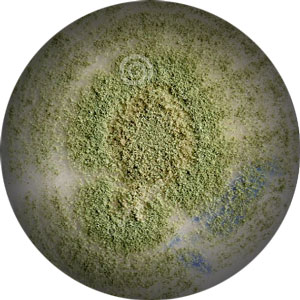
Aspergillus oryzae
(Ahlb.) Cohn 1884
Aspergillus oryzae, commonly known as thekojimold, holds an essential role in Asian cuisine. For centuries, it has been the basis for making fermented food and beverages such as sake, soy sauce (shoyu), and soy paste (miso). Moreover,A. oryzaeis today used to manufacture industrial enzymes for food processing because of its large enzymatic machinery.
What isAspergillus oryzae?
Aspergillus oryzae is an aerobic filamentous fungus of the genusAspergillus。分类学上,它是相关的A. sojae, also sometimes referred to askoji。Interestingly, although very closely related to poisonousA. flavusandA. parasitica,A. oryzaeandA. sojaedo not produce mycotoxins and are readily used in the food industry (1–4).A. oryzaecan commonly grow in soil and on plants and plant debris, particularly from rice. The Latin name of the species comes from the name of the rice species on which the fungus is grown (Oryza sativa).
Morphology and cultivation ofAspergillus oryzae
Aspergillus oryzaeis a filamentous mold fungus, which produces unicellular thread-like structures called hyphae. Hyphae and grow by extension at the terminal tips, branch and form a network of hyphae called a mycelium. Using hyphae, the organism permeates the substrate, which to the mold represents both food and habitat. In this process, the fungus explores and dissolves the starches from its environment. This is howA. oryzaechanges the texture and flavor of foods.
Aspergillus oryzaehas a fast-growing mycelium, and the hyphae will cover the whole petri dish after only several days of incubation. It grows optimally at the temperature between 32–36 °C (89-96°F), with the maximum limit of 44°C (111°F).A. oryzaethrives in an environment with a 5-6 pH. It needs a minimum water activity of 0.8 to properly grow (5,6).
Hyphal growth will continue in a liquid media until the mycelium gets exposed to the air. However, spore-bearing structures are only produced on firm agar media. When grown on agar, the mycelium is initially white due to the growth of only vegetative hyphae. As conidiophores start to appear, the colony turns to yellowish-green. A mature, fresh colony with formed conidia is green, brown when old. Conidia are spherical to slightly oval, 5–8 µm in diameter, with mostly smooth walls (Fig. 1) (5,6).

Aspergillus oryzaeenzyme production
The most appreciated role of theA. oryzaein the food industry is its ability to saccharify starchy substrates. Saccharification is a process where simple sugars (monosaccharides) are released from the starch molecule. This allows simple sugars to be fermented by other microorganisms.
The enzymes involved in the digestion of starches are carbohydrases (alpha-amylase, amyloglucosidase, maltase, sucrase, pectinase, beta-galactosidase, cellulase, hemicellulase, and pentosan-degrading enzymes) and proteinases. Carbohydrases hydrolyze carbohydrates (saccharification) and proteins to simple sugars and amino acids. The combined action of these enzymes are monosaccharides such as D-glucose, D-galactose, D-galacturonic acid, D-rhamnose, D-xylose, and L-arabinose.
Proteinases have the role of increasing the rate of protein breakdown to smaller polypeptides (long-chain components of proteins) or single amino acids (building blocks of proteins).A. oryzaeproduces three acid and two neutral proteinases, which reach their optimum biochemical catalyzation between 20° to 30°C. The mold also produces enzymes called glutaminase, which converts glutamine to glutamic acid. This amino acid is essential for a good quality soy sauce.
Traditional use ofAspergillus oryzae
The common name forA. oryzaein Japan iskojimold.A. sojaealso falls into this category, although in a screening study of molds traditionally used in Japan,A. oryzaeis the species predominantly used to produce fermented foods of this type. Soy sauce production has two steps, starch degradation and fermentation. The first process is substrate colonization, whereA. oryzae(also known asKoji-kin) is inoculated to steamed rice and breaks down starches and proteins (Fig. 2). This produces a starter known as thekoji。

The second step in soy sauce production ismoromifermentation. Here,Kojiis mixed with salt brine to produce a mash (themoromi) which will undergo lactic acid bacteria and yeast fermentations. This process must last for a minimum of one year at room temperatures to produce high-quality soy sauce. This creates such conditions in which only several (targeted) microorganisms can survive. Under these conditions, the Gram-positive bacteria片球菌属晕philusthrives and produces lactic acid, lowering themoromipH to 5.5 or less. Next, the salt-tolerant yeastZygosaccharomyces rouxiistarts to grow, ferment and produce 2-3% alcohol and some other compounds which give characteristic aromas to soy sauce.
Under these salty and acidy conditions,A. oryzaecan’t survive and this mold dies rapidly. Interestingly, its extracellular enzymes, possibly released from the mycelium post mortem (so to say), continue to hydrolyze substrates for the growth of the yeasts and lactic acid bacteria. Even though relatively slower because of the salty and acidy conditions, experiments have shown that most hydrolysis reactions occur at this stage, while at thekojistage, these reactions occur only slightly beyond what is needed to supply the needs of thekojimold. Therefore, the most important function of theA. oryzaein the process of soy fermentation is the production of exocellular protease and carbohydrase enzyme complexes.
Aspergillus oryzaesafety
Even thoughA. oryzaeproduces a large specter of valuable enzymes; it is considered safe for food fermentation. WhileA. oryzaeis genetically very closely related toA. flavus, it does not produce mycotoxins under normal conditions. Some believe thatA. oryzaeis a domesticated sort of theA. flavus(or a closely related species), which has gained various enzymes, increased fermentation rates, and lost the ability to produce aflatoxins through the process of domestication (7,8).Allergic bronchopulmonary aspergillosisdue toA. oryzaeis very rare. Furthermore, because no reports ofA. oryzaeinfections in healthy humans were found, it is generally treated as a non-pathogenic mold species (5,6).
Aspergillus oryzaegenetics
The genome ofAspergillus oryzaehas been completely sequenced and thoroughly investigated because of its multiple applications and importance in several industries (9). The genome ofA. oryzaeis around 36.7 Mb (36,7 million base pairs) long and has a gene number of 12.079 (9). This allowed for insight into possible reasons as to whykojimold is such a prolific enzyme producer. It turns out that all investigated strains possessed two or three copies of amylase-encoding genes, which differ from each other only in one flanking region. What is important is that all of these genes are functional in the mold. Observed multiple functional amylase genes found inA. oryzaecould explain why this species is a hyper producer of a-amylase (5,10).
Bibliography
- Barbesgaard, P., Heldt-Hansen, H. P., & Diderichsen, B. (1992). On the safety ofAspergillus oryzae: a review. Applied microbiology and biotechnology, 36(5), 569-572.
- El-Kady, I., El-Maraghy, S., & Zohri, A. N. (1994). Mycotoxin producing potential of some isolates ofAspergillus flavusandEurotiumgroups from meat products. Microbiological research, 149(3), 297-307.
- Chang, P. K., & Ehrlich, K. C. (2010). What does genetic diversity ofAspergillus flavustell us aboutAspergillus oryzae? International journal of food microbiology, 138(3), 189-199.
- Bennett, S. E. B. J. W. (2007). An overview of the genusAspergillus。TheAspergilli, 23-34.
- Gomi K. Aspergillus:Aspergillus oryzae。In: Encyclopedia of Food Microbiology: Second Edition. Elsevier Inc.; 2014. p. 92–6.
- Powell, K. A., Renwick, A., & Peberdy, J. F. (Eds.). (2013). The genusAspergillus: from taxonomy and genetics to industrial application (Vol. 69). Springer Science & Business Media.
- Kurtzman, C. P., Smiley, M. J., Robnett, C. J., & Wicklow, D. T. (1986). DNA relatedness among wild and domesticated species in theAspergillus flavusgroup. Mycologia, 78(6), 955-959.
- Wicklow, D. T. (1984). Conidium germination rate in wild and domesticated yellow-greenAspergilli。Applied and environmental microbiology, 47(2), 299-300.
- Machida, M., Yamada, O., & Gomi, K. (2008). Genomics ofAspergillus oryzae: learning from the history of Koji mold and exploration of its future. DNA research, 15(4), 173-183.
- Abe, K., Gomi, K., Hasegawa, F., & Machida, M. (2006). Impact ofAspergillus oryzaegenomics on industrial production of metabolites. Mycopathologia, 162(3), 143.
Published:August 18, 2021Updated:October 28, 2021

Written by:
Dusan Sadikovic
真菌学家- MSc,博士学位
官网入口
Fact checked by:
Charles Leduc
CPI, CMI, CMR
官网入口

Looking for mold library dataset or machine learning algorithm for training your AI?
Mold Busters created anopen-source library of microscopy imagesof various kinds of mold which are used to train machine learning algorithms. If you would like to get access to it, just fill out the form below and we will contact you shortly: